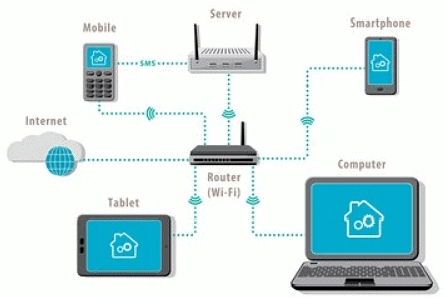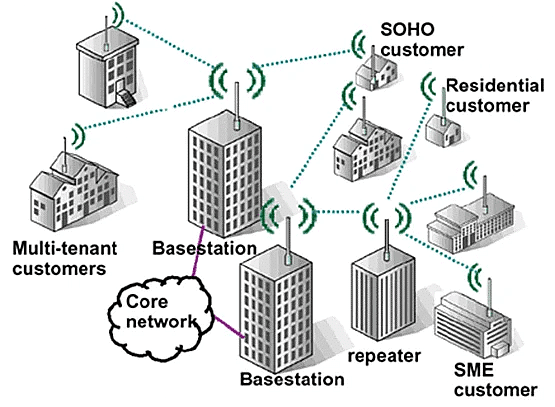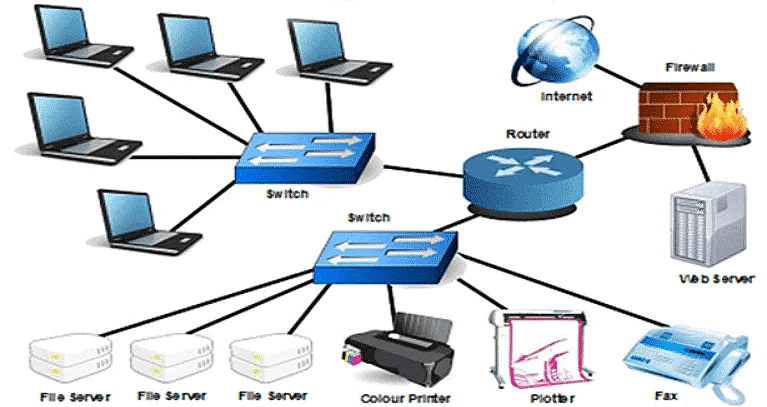Bank Exams Exam > Bank Exams Notes > IBPS PO Prelims & Mains Preparation > Computer Network: Definition and Types
Computer Network: Definition and Types | IBPS PO Prelims & Mains Preparation - Bank Exams PDF Download
Introduction
- A computer network can be defined as a group of computers that utilize a set of common communication protocols over digital interconnections to share resources over the network. A network can be a small one including a handful of systems to a one with millions of devices spread all across the world.
Types of Networks
Local Area Network (LAN)
- This is one of the original and very basic types of network, and also one of the simplest. LAN networks group computers together over comparatively small distances, such as within a single building or a small group of buildings, schools, offices, colleges, universities, etc to share resources such as printers, file servers, scanners, and the internet.

- Often they do not contain more than one subnet and are generally controlled by a single administrator. The communication medium used for LAN is twisted pair, coaxial cable, etc, and is build with less costly or inexpensive hardware such as hubs, network adapters, and ethernet cables.
- The data is carried at an extremely accelerated rate in the Local Area Network with added higher security. It principally works on private IP addresses and does not include heavy routing. LAN can be wired, wireless, or in both styles at once.
Personal Area Network (PAN)
- The smallest and most primary type of network, a PAN is composed of a wireless modem, a computer or two, phones, laptops, Bluetooth-enabled devices or infrared-enabled devices, media player, printers, tablets, etc., and revolves around one individual in one building.
- This may also incorporate a wireless computer keyboard and mouse, Bluetooth-enabled headphones, wireless printers, and TV remotes. These types of networks are typically observed in small offices or residences and are controlled by one person or organization from a single device.
- PAN possesses a connectivity span of up to 10 meters. There are two types of Personal Area Network: Wired Personal Area Network and Wireless Personal Area Network.
Metropolitan Area Network (MAN)
- MAN is a kind of network which is bigger than a LAN but smaller than a WAN and incorporates properties of both. It typically covers a town or city and is controlled by a single person or company, such as a local council or a large company. The most extensively used protocols in MAN are RS-232, ATM, Frame Relay, ISDN, ADSL, OC-3, etc. It has a longer range than Local Area Network(LAN).

- This type of network can be applied to connect citizens with various Organisations for example communication between the banks in a city, employed in college within a city, Government and private organizations use MAN to connect all its offices within the city.
Wide Area Network (WAN)
- This is another kind of the original category of network and is Slightly more complex than a LAN. WAN networks encapsulate computers together over huge physical distances, remotely connecting them over a network and allowing them to communicate even when far apart.

- The Internet is an example of WAN which connects computers all around the world together. WANs are generally too large to be controlled by one administrator, and so generally have collective ownership, or in the case of the internet, is publicly owned. WAN is a general connection between LANs and MANs, that is not restricted to a single location, but it traverses over a large geographical area through a telephone line, fibre optic cable, microwaves, or satellite links.
- A Wide Area Network is extensively applied in the field of business, government, and education. The data communication is slowest in WAN due to the largest distance. The installation cost of WAN is very high and utilizes advanced technologies such as Asynchronous Transfer Mode (ATM), Frame Relay, and Synchronous Optical Network (SONET).
Other Types of Network
There are also other types of network users may encounter. Some of these are distinct, but most are developed from LAN and WAN networks to have slight variation and adapt to different user needs. These include:
- Campus Area Network (CAN): This is a network that is bigger as compared to a LAN, but smaller than a MAN. This is very common in areas like a university, large school, or small business. CAN spread over several buildings which are reasonably local to each other. It can have an internal Ethernet along with the capability of connecting to the internet. Its also referred to as a “Corporate Area Network”.
- Wireless Local Area Network (WLAN): This is a LAN that is implemented with the use of wireless network technology such as Wi-Fi. This kind of network is becoming more popular these days as wireless technology is further developed and is used commonly in the home and small businesses. In other words, devices do not need to be dependent on physical cables and wires as much and can organize their spaces more effectively.
- System Area Network (SAN): System area network combines computers on an especially high-speed connection, in a configuration known as a cluster(server-to-server applications). It means computers that are linked in a group to work as a single system, and can be implemented as a result of very high-speed computers and new low-cost microprocessors. They are generally used to enhance performance and for cost-effectiveness.
- Storage Area Network (SAN): This network links servers directly to devices which store large amounts of data without depending on a LAN or WAN network to do so. This can include another type of connection known as Fibre Channel, a structure similar to Ethernet which manages high-performance disk storage for applications on a variety of professional networks. Types of storage-area networks include virtual, converged, and unified SANs.
- Virtual Private Network (VPN): A Virtual Private Network or VPN is a private network that lets its users transmit and accept data as if their devices were connected to the private network and even if they are not. These systems use encryptions and other security tools to guarantee authorized user’s access. Through a virtual point-to-point link, users can enter a private network remotely.
Modes of Communication in Computer Networking
Transmission mode or communication mode serves as a medium of transferring data between two devices. There are mainly three types of transmission/ communication mode- simplex, half-duplex, and full-duplex. Let us understand each of them briefly;
- Simplex mode: The mode of communication is unidirectional in Simplex mode. This implies data can flow in one direction only i.e either a device can send data or receive data at a single instance but cannot perform both operations. Keyboard and Monitor are examples of the simplex mode. A keyboard can only receive the data from the user on the other hand a monitor can only be utilized to display the data or information on the screen. In simplex mode, the full capacity of the communication channel can be applied during transmission.
- Half-Duplex mode: In half-duplex mode, each channel can transmit and receive data, but not at the same time. When one device is transmitting data, the other can only receive the data, and vice versa. The half-duplex mode is used in cases where there is no requirement for communication in both directions at a particular instant. The complete potential of the channel can be utilized for each direction. A Walkie-talkie is an illustration of the Half-duplex mode.
- Full-Duplex mode: In a full-duplex communication mode, the communication between sender and receiver can take place simultaneously. That is a sender and receiver can both send and receive data at the same time. The full-duplex transmission mode is like a two-way road, in which traffic can move in both directions at the same point. A telephonic conversation between two individuals is a type of full-duplex communication. The Full-duplex mode is the most active mode of communication between devices.
The document Computer Network: Definition and Types | IBPS PO Prelims & Mains Preparation - Bank Exams is a part of the Bank Exams Course IBPS PO Prelims & Mains Preparation.
All you need of Bank Exams at this link: Bank Exams
|
647 videos|1000 docs|305 tests
|
Related Searches
















